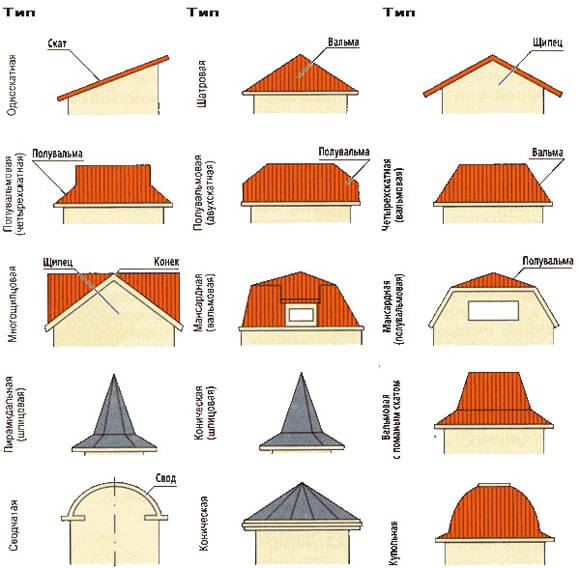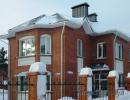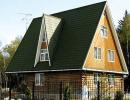Types of roofing for pitched roofs
As you know, a pitched roof is a roof whose slope angle exceeds 5 degrees. It's no secret that pitched roof designs can be very different, both simple and complex. But for all of them, one rule must be strictly followed - the installation of high-quality waterproofing.
Types of pitched roofs
First, you need to consider in detail what types of pitched roofs exist:

It is no secret that the complexity and shape of the roof is directly affected by the complexity and cost of its rafter system.

It is quite possible to build this system yourself, just as you can install lathing for a single-pitched or gable roof, it is only important to remember that a simpler pitched roof system will require less money, as well as less time spent on work.
Of course, installing a roof equipped with many elements is considered more difficult.
Regardless of the complexity of the particular roof being installed, one way or another, it is imperative to install all protective and insulating layers for it. This does not apply only to cold roofs, which are installed not for residential premises, but for structures such as a workshop, barn, etc. For such a roof, it will only be enough to equip it with a waterproofing layer.

Based on the type of arrangement, pitched roofs are divided into attic and non-attic. The second option is more acceptable when constructing industrial enterprises or apartment buildings.
Thermal insulation for pitched roofs
Private country houses and cottages are characterized by attic roofs, made either in a cold or insulated version.
As you know, high-quality thermal insulation, and with it noise insulation, directly depends on the quality of the materials used. Since the temperate climate does not allow the installation of cold roofs for houses due to rather harsh winters, insulated roofs are not just a waste of money, it is a necessity. And provided that the insulation is light in weight, environmentally friendly and durable, then the roof itself will last much longer and does not require any intervention during its operational life.
Thermal insulation of pitched roofs, detailed video:
First, you need to lay a layer of vapor barrier, followed by insulation, and the whole process should be completed by laying waterproofing, as a result of which the roof will be reliably protected from the penetration of water, cold and external noise.
One of the leaders in the modern market of thermal insulation materials is a sample called “GLASSWOOL”. Due to the German production standard, the insulation is ideal for climate conditions in the temperate zone.
The material is capable of excellent heat retention; in addition, its sound insulation properties are also high. The insulation mats have a thickness of 15 centimeters, which is very convenient for single-layer installation in the space between the rafters. The parameters of the insulation sheets are 120x420 centimeters.
The material is elastic, durable and resistant to both mechanical and natural influences, thereby extending its service life.

For more detailed information about laying insulation for pitched roofs with a description of the entire progress of work with photos and videos, you can use the Internet, where you can easily find all the data on specialized construction sites.
Thus, it is important to remember that when choosing a pitched roof, you should be guided not only by preferences regarding its appearance, because the main thing is that the roof is not only aesthetically attractive, but also reliable.






